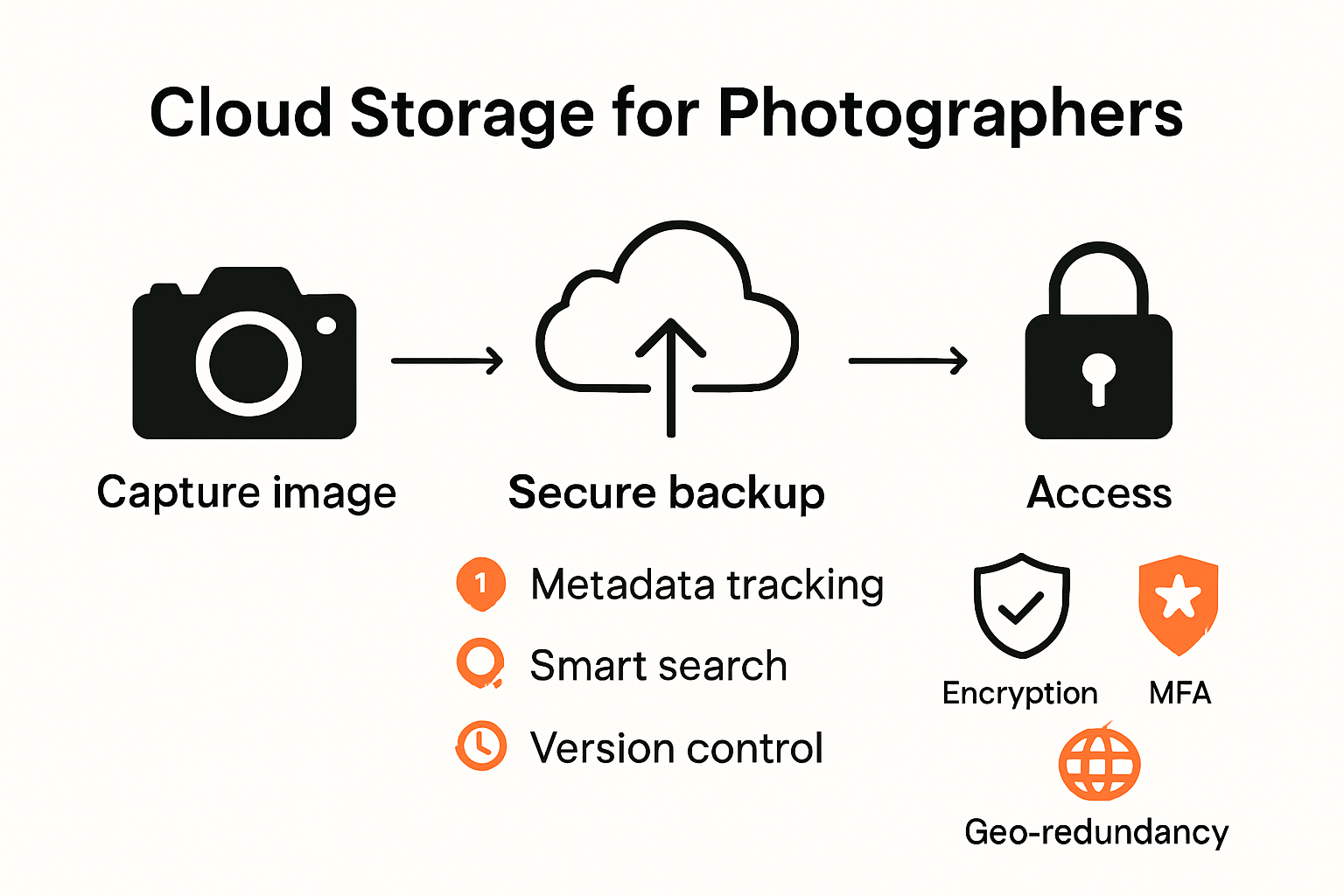Photographers handle thousands of high-res images and need a storage system that keeps pace with rapid shoots and tight deadlines. Most people think grabbing any cloud storage plan will do the trick. But missing the right features can mean losing precious work or even client trust, especially when Adobe’s Photography plan starts with just 20 GB of storage at $9.99 a month while IDrive offers a massive 10 TB for only $3.98 a year. Not all storage is created equal and the smartest pick could completely change how you work.
Table of Contents
- Key Features Of Cloud Storage For Creatives
- Top Cloud Storage Picks For Photographers
- Comparing Plans, Pricing, And Scalability
- Workflow Tips For Teams And Agencies
Quick Summary
| Takeaway | Explanation |
|---|---|
| Choose a cloud storage that integrates with creative tools | Opt for platforms like Adobe Creative Cloud for seamless workflow between storage and editing applications. |
| Prioritize security features for your digital assets | Select services with end-to-end encryption and multi-factor authentication to protect valuable photography work. |
| Evaluate pricing models based on your needs | Consider plans that offer flexible payment schemes like per-user or consumption-based pricing for better value. |
| Look for scalability options for future growth | Ensure the platform can easily expand storage as your needs increase with higher-resolution files and projects. |
| Implement strong digital asset management protocols | Use standardized naming conventions and metadata tagging to enhance file organization and retrieval in cloud storage. |
Key Features of Cloud Storage for Creatives
Professional photographers require sophisticated digital storage solutions that go far beyond basic file preservation. Modern cloud storage platforms offer comprehensive features designed specifically for visual content creators, transforming how creative professionals manage, protect, and share their digital assets.
Intelligent Storage and Organization
Cloud storage solutions provide photographers with advanced organizational capabilities that dramatically improve workflow efficiency. These platforms enable systematic categorization through intelligent tagging, metadata management, and automated folder structures. Explore advanced photo management techniques for seamless digital asset control.
According to research from Box, professional cloud storage platforms offer centralized storage that allows photographers to access their entire photo library from any device with internet connectivity. This flexibility enables remote work and on-the-go image management, critical for modern creative professionals who often work across multiple locations and devices.
Key organizational features include:
- Automated Metadata Tracking: Preserves critical image information like capture date, camera settings, and location
- Smart Searching: Enables rapid retrieval of specific images through advanced filtering
- Version Control: Documents each edit iteration, allowing easy reversion to previous file states

Security and Protection Mechanisms
Data security represents a paramount concern for photographers managing high-value visual content. Cloud storage platforms implement robust protection strategies that safeguard sensitive professional assets. Caltech’s research highlights multiple critical security features inherent in advanced cloud storage systems.
Comprehensive security protocols typically encompass:
- End-to-End Encryption: Protects files during transmission and storage
- Multi-Factor Authentication: Prevents unauthorized access through layered verification
- Geo-Redundant Backups: Ensures data survival through distributed storage locations
Professional photographers can leverage these features to create an impenetrable digital vault for their most valuable creative work, mitigating risks associated with hardware failure, theft, or accidental deletion.
Collaboration and Workflow Integration
Modern cloud storage platforms transcend traditional storage paradigms by offering robust collaboration tools. These systems enable seamless file sharing, client proofing, and integrated workflow management. By supporting direct integrations with editing software and providing customizable sharing permissions, cloud storage becomes an essential productivity enhancement tool.
Advanced cloud storage solutions facilitate:
- Real-Time Collaboration: Multiple team members can simultaneously access and edit files
- Client Galleries: Create professional, branded galleries for client review
- Direct Software Integration: Smooth transfer between storage and editing platforms
By understanding and leveraging these sophisticated features, professional photographers can transform their digital asset management from a mundane technical task into a strategic advantage that supports creative excellence and business growth.
Top Cloud Storage Picks for Photographers
Photographers require specialized cloud storage solutions that accommodate high-resolution files, provide robust security, and support professional workflows. The best platforms in 2025 offer tailored features that go beyond generic file storage, addressing the unique needs of visual content creators.
Professional-Grade Storage Solutions
Choosing the right cloud storage platform can significantly impact a photographer’s productivity and data management strategy. Explore professional storage comparisons to make an informed decision.
According to PetaPixel’s analysis, Adobe Creative Cloud stands out as a premier option for photographers. Their Photography plan offers 20 GB of storage at $9.99 per month, with an expanded 1 TB option available at $19.99 per month. This platform provides seamless integration with Lightroom and Photoshop, creating a comprehensive ecosystem for creative professionals.
Key considerations for professional-grade storage include:
- Storage Capacity: Minimum 1 TB recommended for extensive photo libraries
- File Format Support: Compatibility with RAW, TIFF, and high-resolution file types
- Editing Software Integration: Smooth workflow between storage and editing platforms
Specialized Features for Creative Professionals
TechRadar’s 2025 guide highlights several standout platforms tailored for photographers. IDrive emerges as a cost-effective solution, offering up to 10 TB of storage for just $3.98 annually. The platform includes advanced features like facial recognition and unlimited device backup, which are crucial for photographers managing extensive visual archives.
Notable platforms with unique offerings include:
- pCloud: Lifetime storage options and comprehensive RAW file support
- Internxt: Zero-knowledge encryption for maximum data security
- SmugMug: Portfolio presentation and integrated sales tools
Below is a comparison table summarizing the top cloud storage options mentioned in this section, highlighting their key features and pricing.
| Platform | Starting Price | Storage Included | Key Features |
|---|---|---|---|
| Adobe Creative Cloud | $9.99/mo (20 GB), $19.99/mo (1 TB) | 20 GB or 1 TB | Lightroom & Photoshop integration, editing workflow |
| IDrive | $3.98/year (10 TB) | Up to 10 TB | Advanced features, facial recognition, unlimited devices |
| pCloud | $199 one-time (lifetime) | 2 TB (lifetime option) | RAW support, lifetime plans, comprehensive features |
| Internxt | $4.99/mo (500 GB) | 500 GB–10 TB | Zero-knowledge encryption, privacy-focused |
| SmugMug | $13/mo (Basic) | Unlimited | Portfolio and sales tools, client gallery, branding |
Workflow and Collaboration Considerations
Modern photographers need more than just storage space. The ideal cloud solution should support collaborative workflows, client interactions, and seamless content sharing. Comparing alternative platforms can help photographers identify the most suitable solution for their specific needs.
As Aftershoot’s research indicates, the best cloud storage platforms in 2025 offer more than simple file preservation. They provide integrated ecosystems that support every stage of a photographer’s workflow from capture to client delivery.
Critical collaboration features to evaluate:
- Client Gallery Options: Professional sharing and proofing capabilities
- Access Controls: Granular permissions for team and client interactions
- Cross-Platform Compatibility: Seamless access across devices and operating systems
Selecting the right cloud storage solution requires carefully weighing individual professional requirements, budget constraints, and specific workflow needs. Photographers should prioritize platforms that offer not just storage, but a comprehensive toolkit for managing, editing, and sharing visual content efficiently and securely.
Comparing Plans, Pricing, and Scalability
Photographers require flexible cloud storage solutions that adapt to their evolving business needs. Understanding the nuanced pricing structures and scalability options becomes crucial for making informed decisions that balance budget constraints with professional requirements.
Storage Tier Strategies
Explore pricing strategies for creative professionals to optimize your digital asset management approach. According to Digital Trends’ comprehensive analysis, professional photographers should evaluate cloud storage platforms across multiple dimensions beyond simple per-gigabyte pricing.
Storage tier considerations include:
- Entry-Level Plans: Typically 100-500 GB, ideal for emerging photographers
- Professional Tiers: 1-5 TB with advanced features
- Enterprise Solutions: Unlimited storage with comprehensive team management tools
Below is a summary table outlining the different storage tiers, their target users, and typical features as discussed above.
| Storage Tier | Typical Size | Target User | Key Features |
|---|---|---|---|
| Entry-Level | 100–500 GB | Beginners/Emerging Photographers | Affordable, basic features |
| Professional | 1–5 TB | Seasoned Professionals | Advanced features, editing integration |
| Enterprise | Unlimited | Agencies/Teams | Team management, collaboration tools |
Pricing Model Breakdown
TechRadar’s 2025 cloud storage guide reveals diverse pricing models that cater to different professional photography segments. The market now offers more flexible options than traditional fixed-rate structures.
Pricing models typically encompass:
- Per-User Pricing: Charges based on team member count
- Flat-Rate Storage: Fixed monthly or annual fees for specific storage volumes
- Consumption-Based Pricing: Pay only for storage and bandwidth used
Key pricing insights from Tom’s Guide highlight that professional photographers should look beyond base pricing and evaluate total cost of ownership, including:
- Data transfer fees
- Additional feature costs
- Long-term contract discounts
- Potential overage charges
Scalability and Future-Proofing
Modern cloud storage solutions must accommodate rapid growth and changing technological landscapes. Discover seamless platform transitions to ensure your storage strategy remains adaptable.
Scalability factors photographers must consider:
- Automatic Storage Expansion: Platforms offering seamless storage increases
- Flexible Upgrade Paths: Easy transitions between storage tiers
- Integration Capabilities: Compatibility with emerging photography technologies
Successful cloud storage selection goes beyond immediate needs. Photographers must anticipate future requirements, considering potential business growth, increasing file sizes from higher-resolution cameras, and evolving collaborative workflows.
Ultimately, the ideal cloud storage solution provides a balanced approach. It should offer competitive pricing, robust scalability, comprehensive features, and the flexibility to adapt to changing professional demands. Photographers are advised to conduct thorough comparisons, leverage free trials, and carefully assess long-term value rather than focusing solely on immediate cost savings.
Workflow Tips for Teams and Agencies
Photography teams and creative agencies require sophisticated workflow strategies that transcend traditional file management. Effective cloud storage solutions in 2025 demand comprehensive approaches that integrate technology, collaboration, and strategic asset management.
Optimizing Digital Asset Management
Learn advanced project organization techniques to transform your team’s productivity. According to Box’s best practices, successful digital asset management hinges on establishing clear organizational protocols and leveraging intelligent cloud storage features.
Key organizational strategies include:
- Standardized Naming Conventions: Create consistent file and folder naming systems
- Metadata Tagging: Implement comprehensive metadata strategies for rapid search and retrieval
- Access Hierarchy: Design granular permission structures for different team roles
Collaborative Workflow Optimization
TechBullion’s analysis reveals that modern creative teams require more than simple file storage. Collaborative workflows demand integrated platforms that support real-time editing, version control, and seamless communication.
Essential collaboration features to implement:
- Real-Time Editing: Simultaneous file access and modification
- Comment and Annotation Systems: Enable precise feedback mechanisms
- Automated Workflow Tracking: Monitor project progress and file transformations
Strategic Team Management
Exploring collaborative editing strategies can revolutionize team productivity. Globaledit’s workflow management insights emphasize the importance of continuous process refinement and technological integration.
Critical team management considerations:
- Regular Process Audits: Continuously evaluate and optimize workflow efficiency
- Technology Integration: Select platforms with robust API connections
- Training and Standardization: Develop comprehensive team guidelines for digital asset management
Successful photography teams recognize that effective workflow management extends beyond technological tools. It requires a holistic approach that combines strategic planning, technological understanding, and adaptable communication protocols. By implementing these advanced strategies, creative agencies can transform their digital asset management from a potential bottleneck into a competitive advantage, ensuring faster turnaround times, improved collaboration, and superior project outcomes.

Frequently Asked Questions
What features should professional photographers look for in cloud storage?
Professional photographers should prioritize intelligent storage and organization, robust security and protection mechanisms, and collaboration and workflow integration features in their cloud storage solutions. These include automated metadata tracking, end-to-end encryption, and tools for real-time collaboration.
How can cloud storage improve my workflow as a photographer?
Cloud storage can significantly enhance your workflow by providing centralized access to your photo library from any device, facilitating real-time collaboration with team members or clients, and integrating seamlessly with editing software, saving you time during the editing process.
What are storage tier strategies for photographers?
Storage tier strategies involve selecting different plans based on your needs. Entry-level plans suit beginners, while professional tiers offer higher capacities and advanced features. Evaluating these tiers helps photographers manage their data effectively without unnecessary costs.
Why is data security important for photographers using cloud storage?
Data security is crucial for photographers because it protects valuable digital assets from threats like unauthorized access, theft, and data loss. Using cloud storage with strong security measures such as encryption and multi-factor authentication ensures that your work remains safe and confidential.
Level Up Your Photography Workflow With Pikd
If you are tired of chasing endless file versions and worrying about secure, beautiful delivery, you are not alone. The article highlighted how traditional cloud storage often falls short for photographers who need powerful organization, optimized galleries, and seamless collaboration with clients and teams. Pain points like missing integrations, lack of control, and cumbersome client proofing can put your reputation at risk and slow your business down.

With Pikd, you move beyond basic cloud storage and step into a workspace built just for professional creative work. Upload high-res images, share private galleries instantly, and gather real-time comments or approvals without delays or clunky tools. Take control of your brand with beautifully organized projects and deliver work flawlessly from capture to final export. Your creative process deserves more. Discover the difference and empower your next shoot at Pikd’s homepage or learn how to organize creative projects smarter. Now is the moment to make your workflow as sharp as your images.
Recommended
- PIKD vs. Dropbox: The Best Dropbox Alternative for Photographers
- Cloud Storage for Creatives: Best Solutions for 2025 - Webflow HTML website template
- Backup Strategies for Photographers: Essential 2025 Guide - Webflow HTML website template
- PIKD vs. SmugMug: The Best SmugMug Alternative for Photographers
- 8 Ways to Market Your Photography Services | Effortlessly Professional Websites
- storage for businesses

































